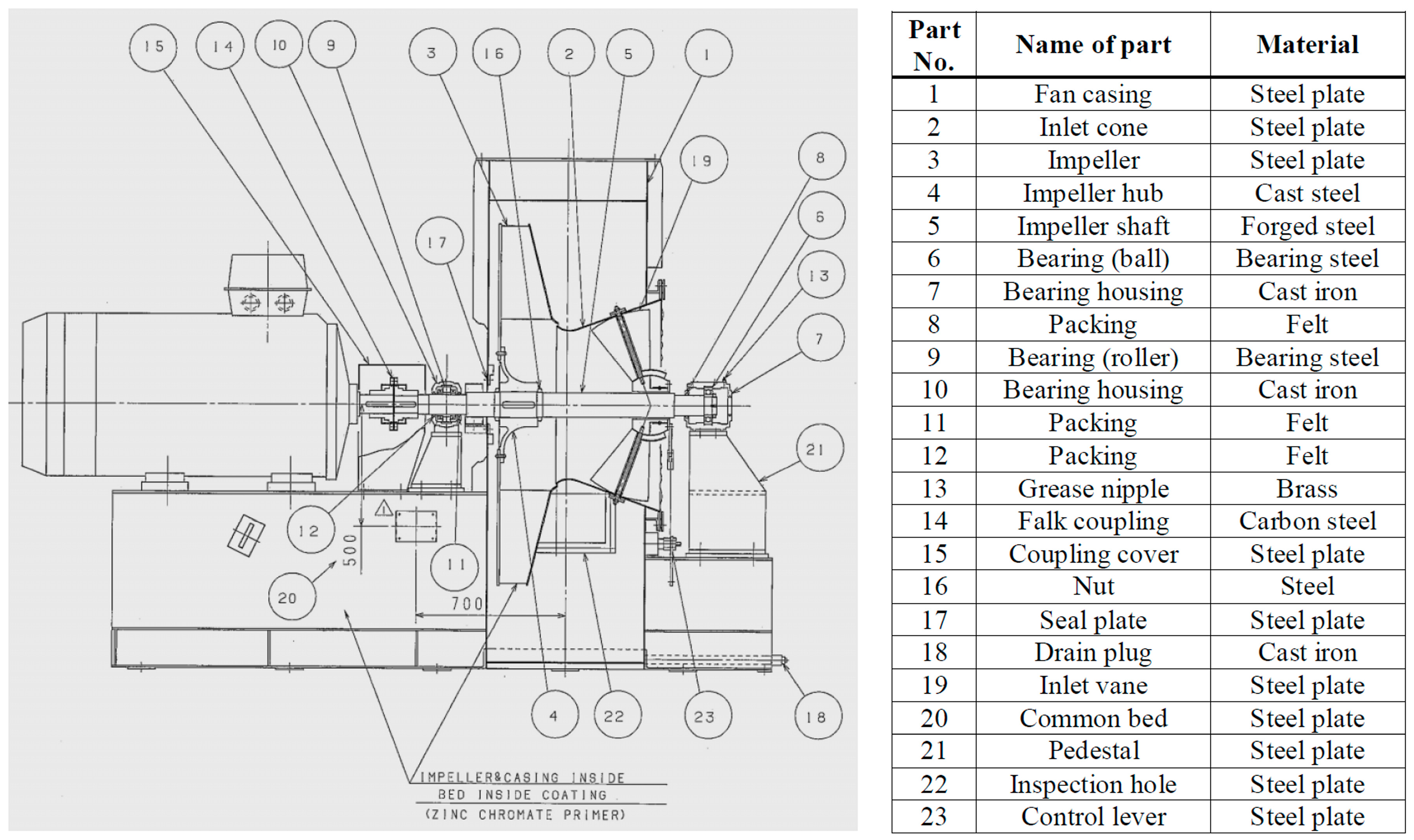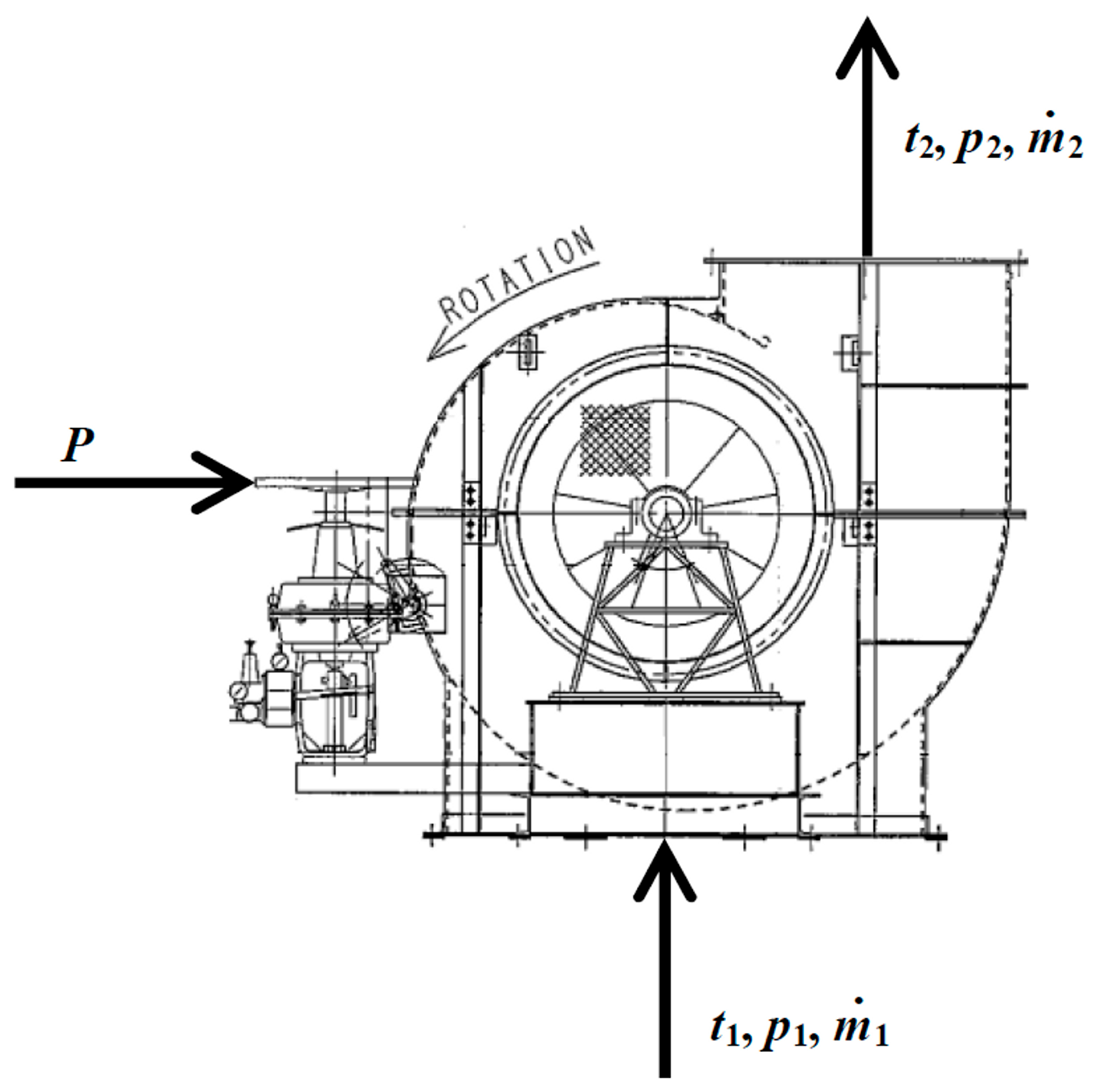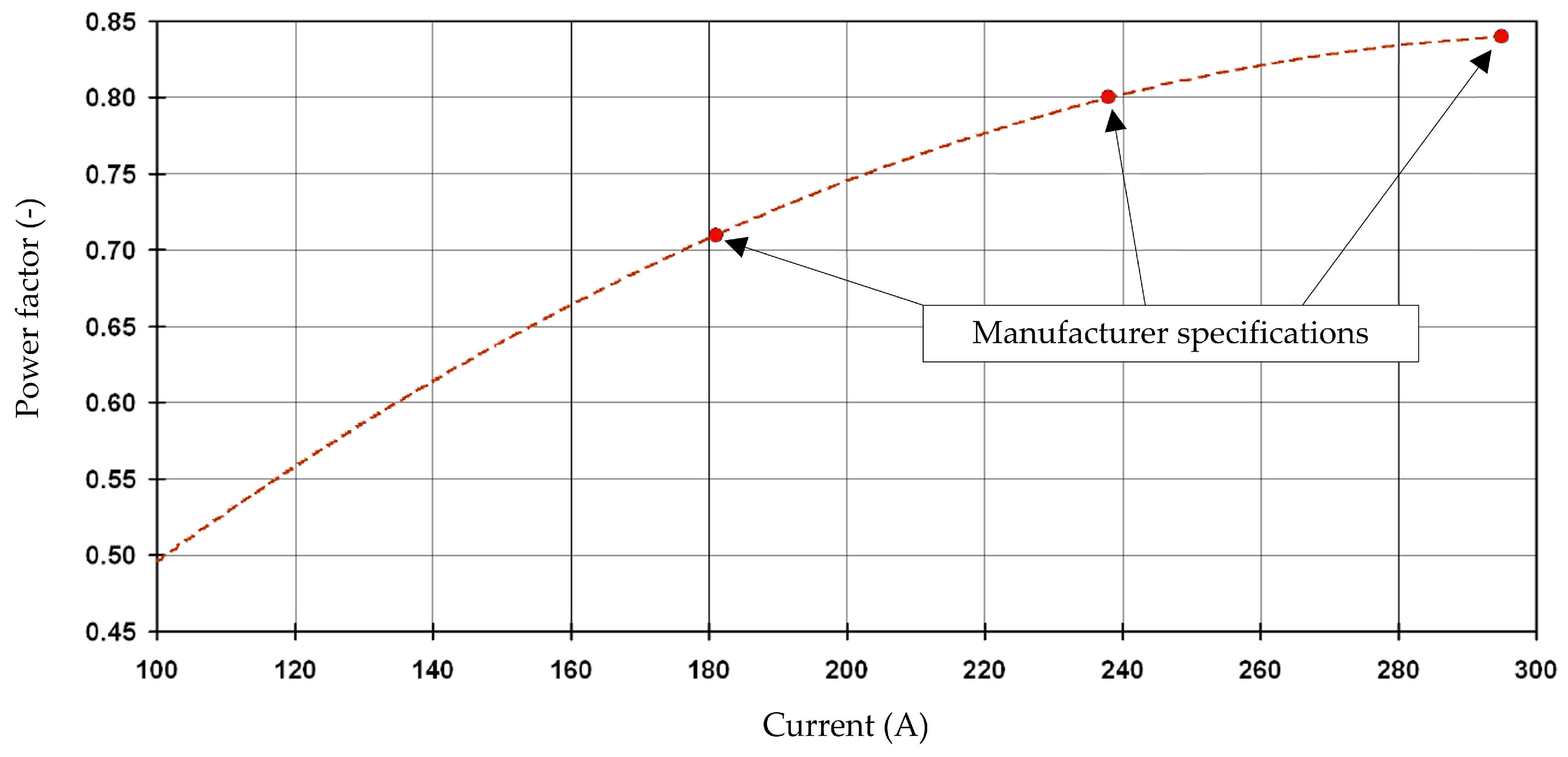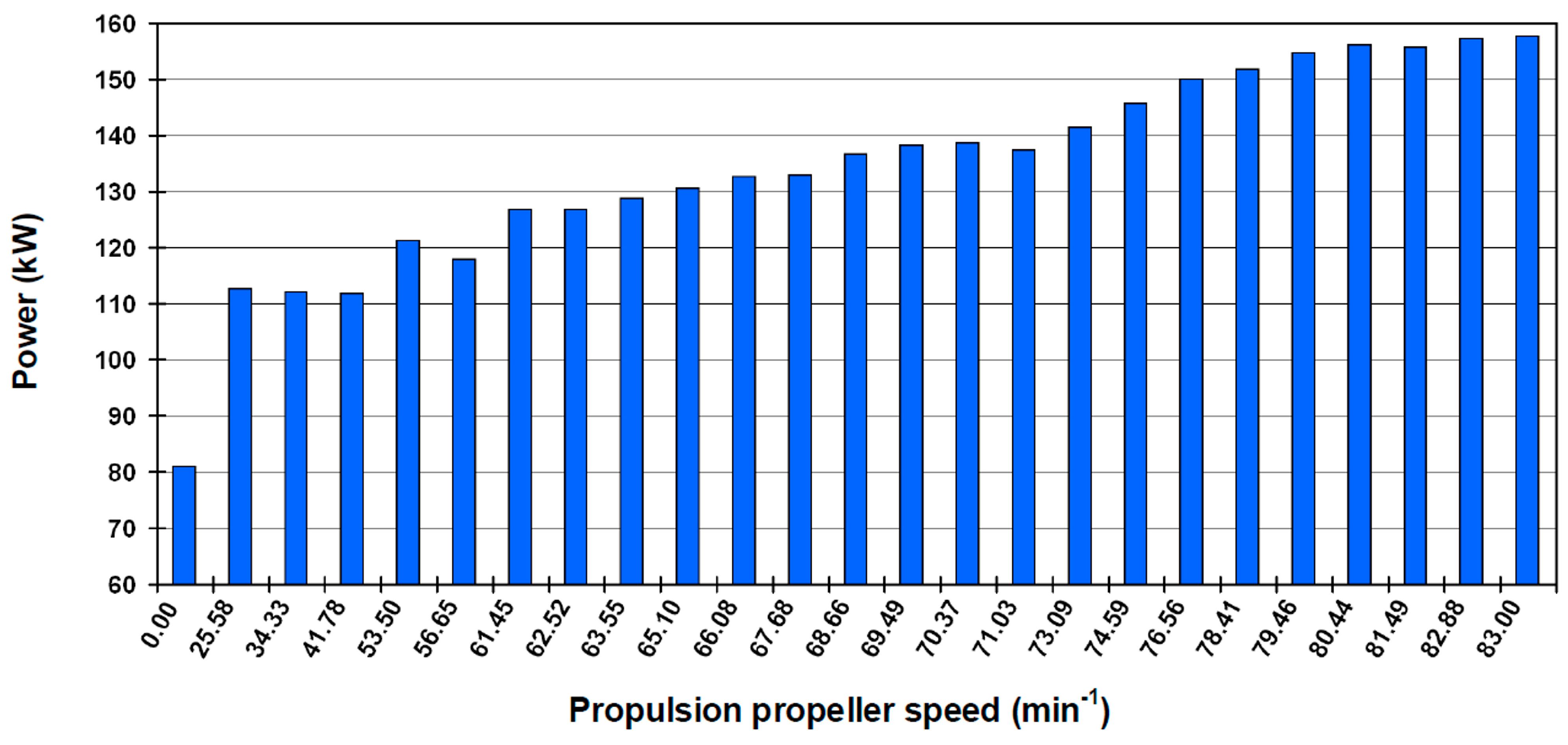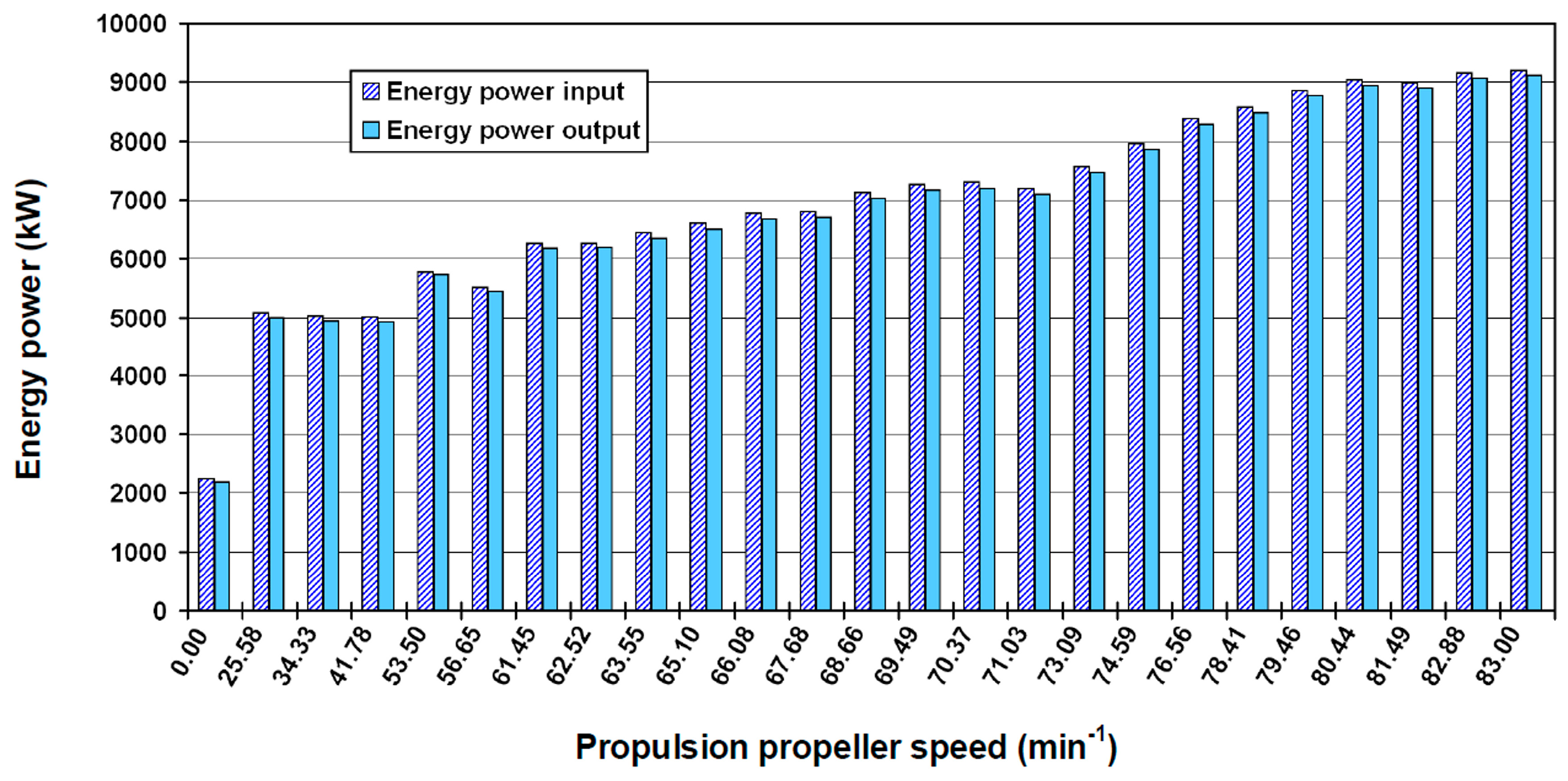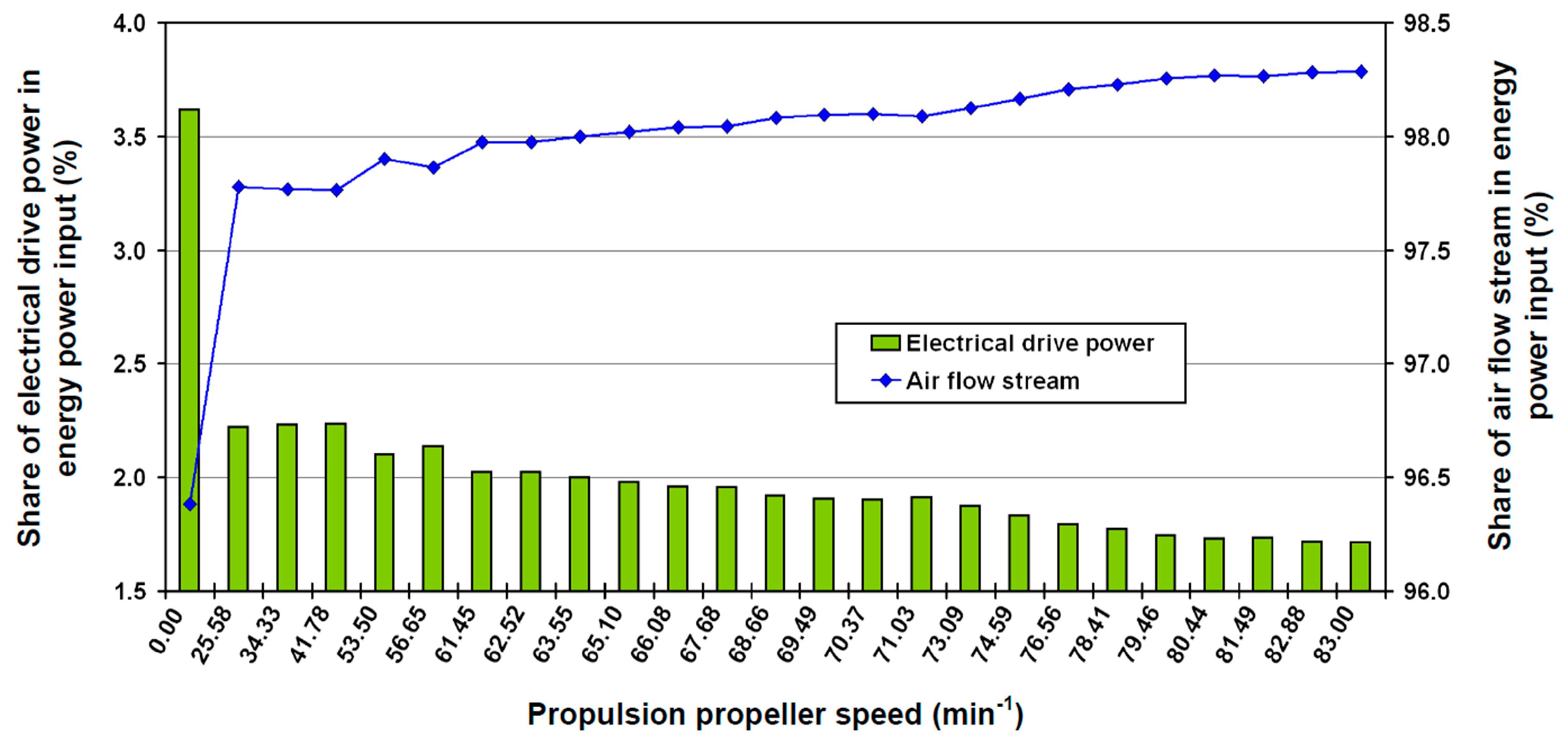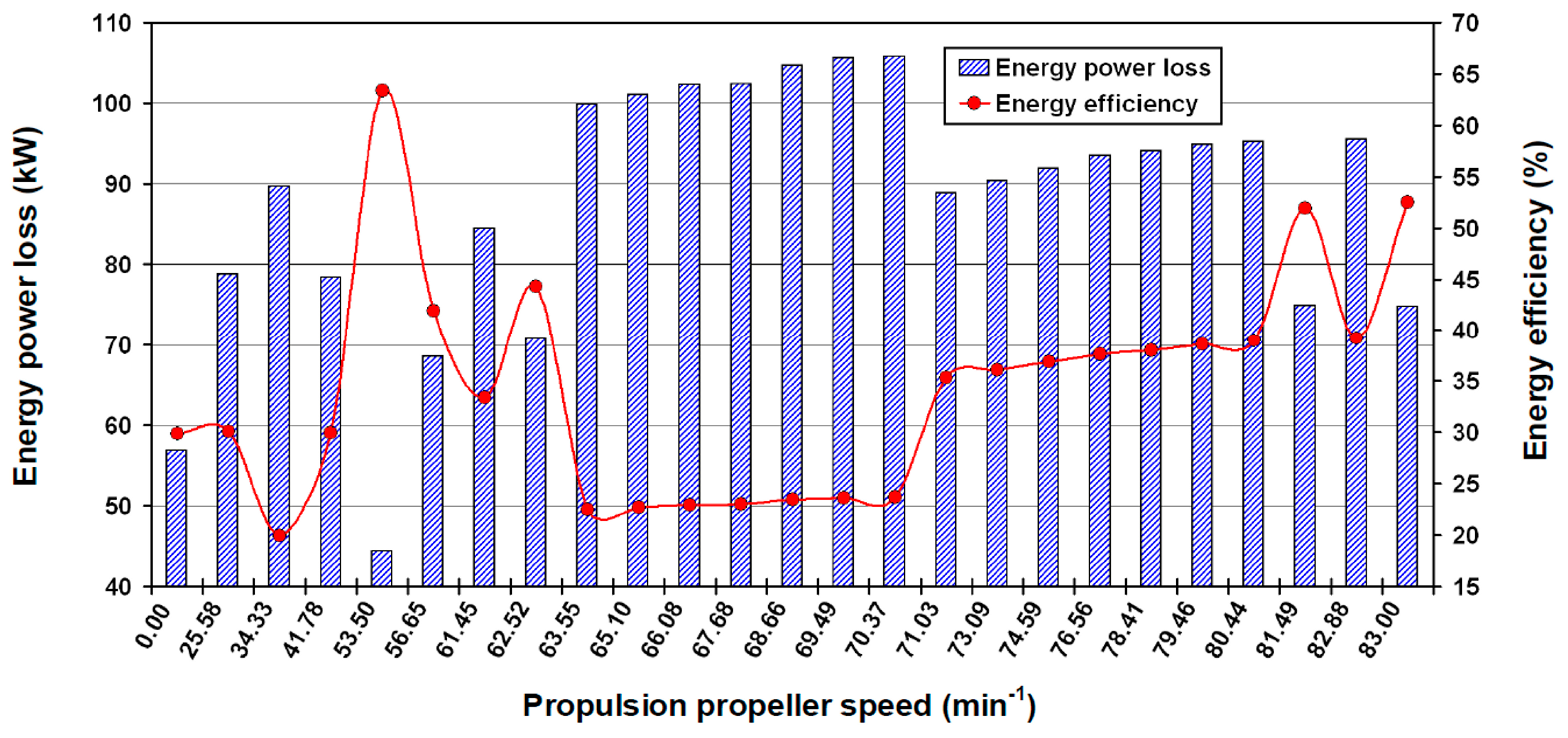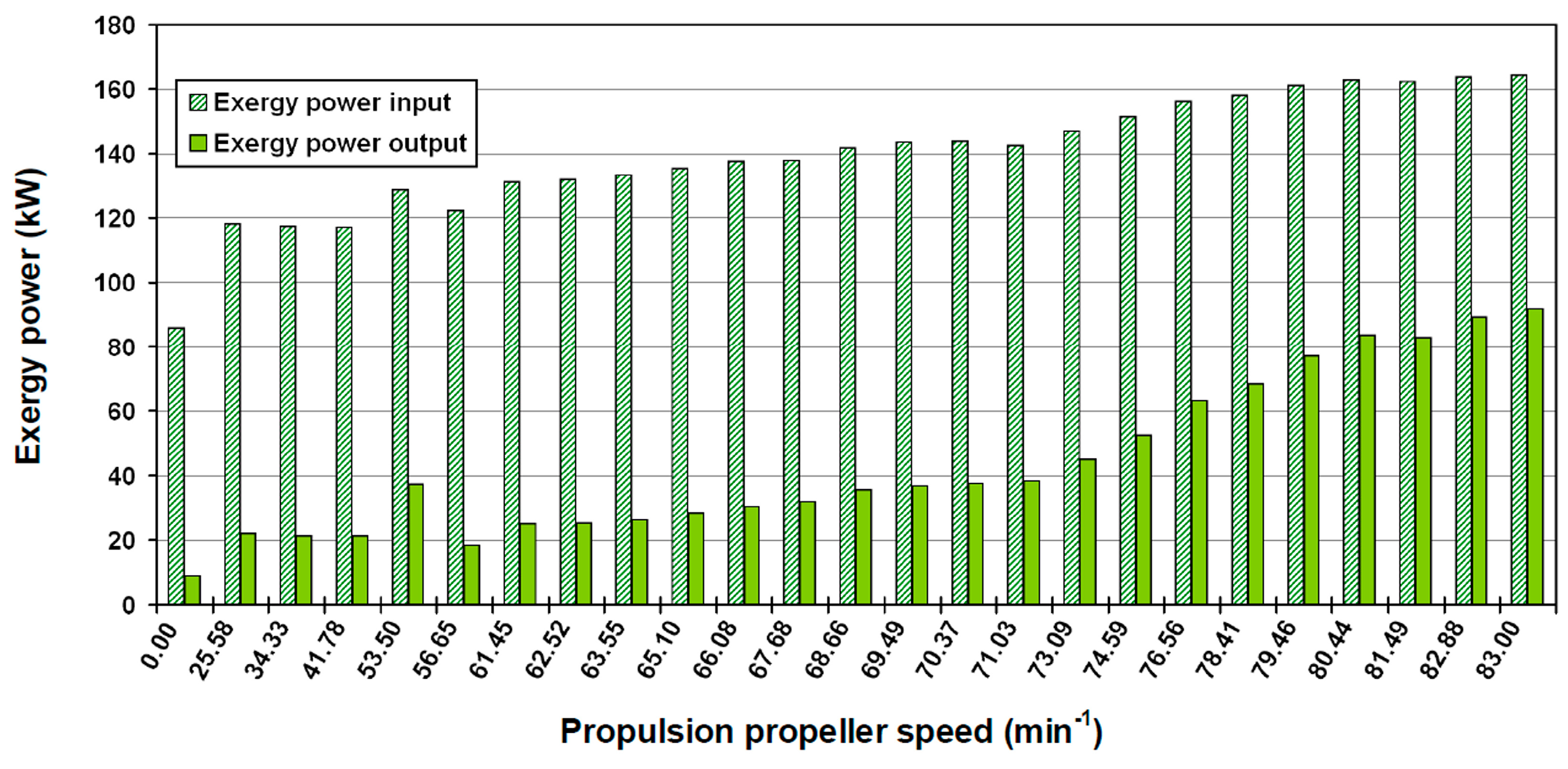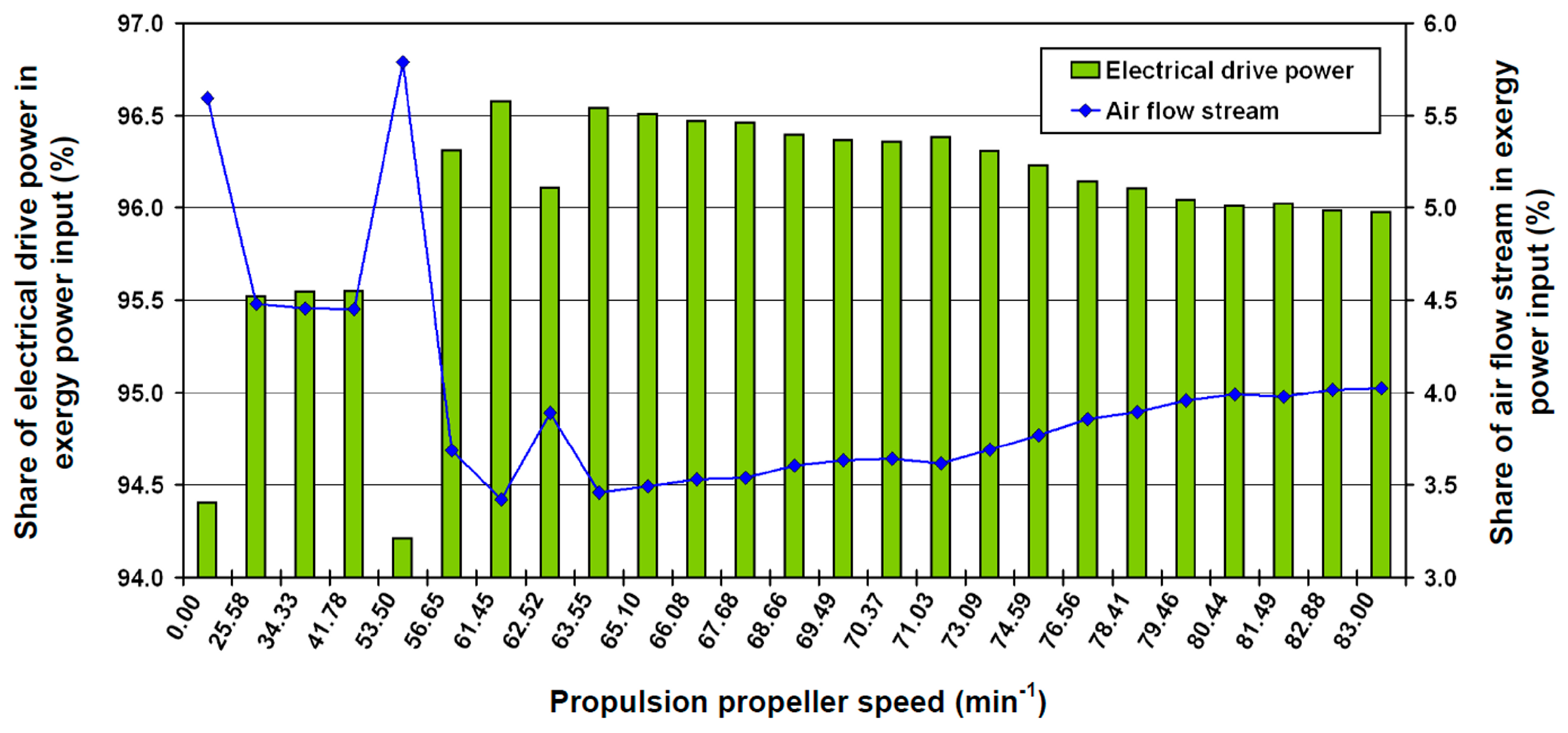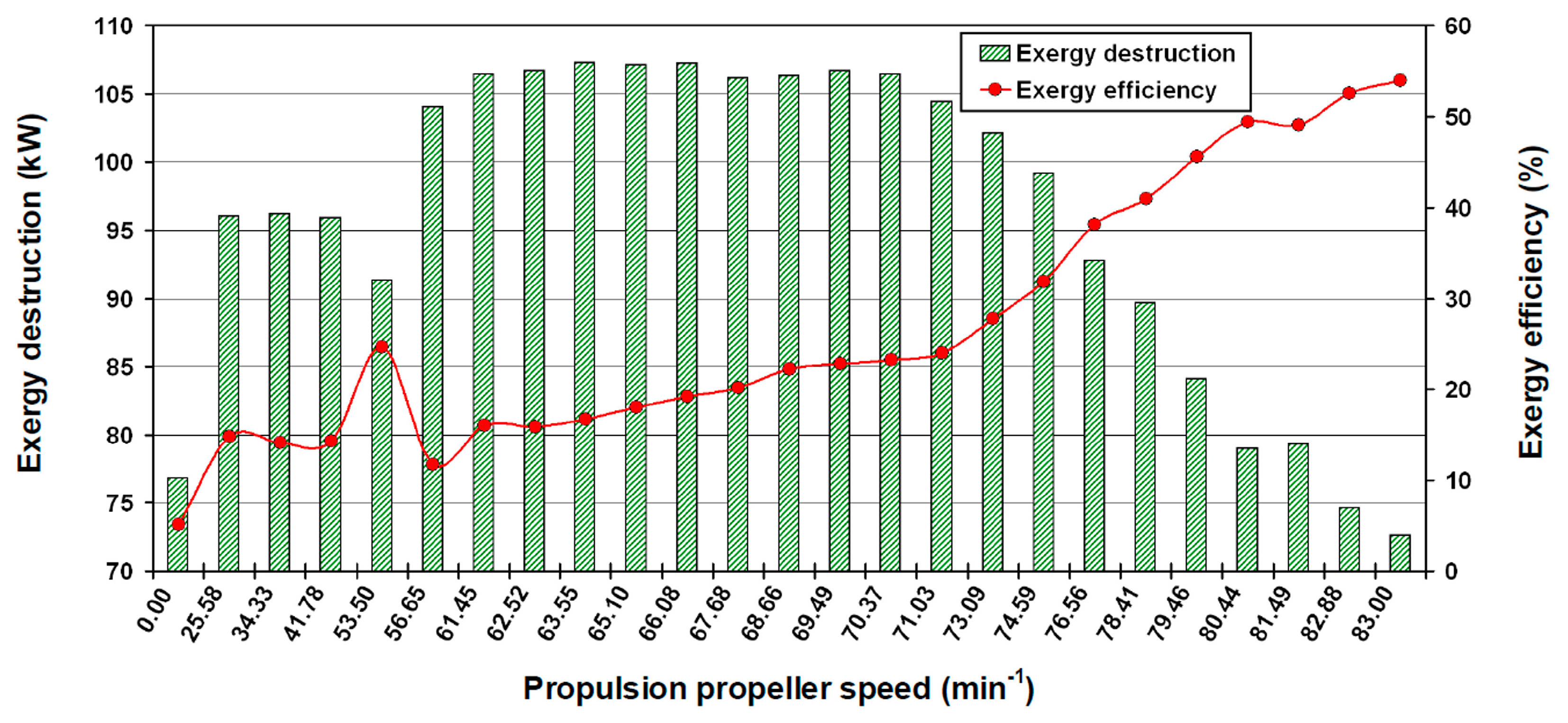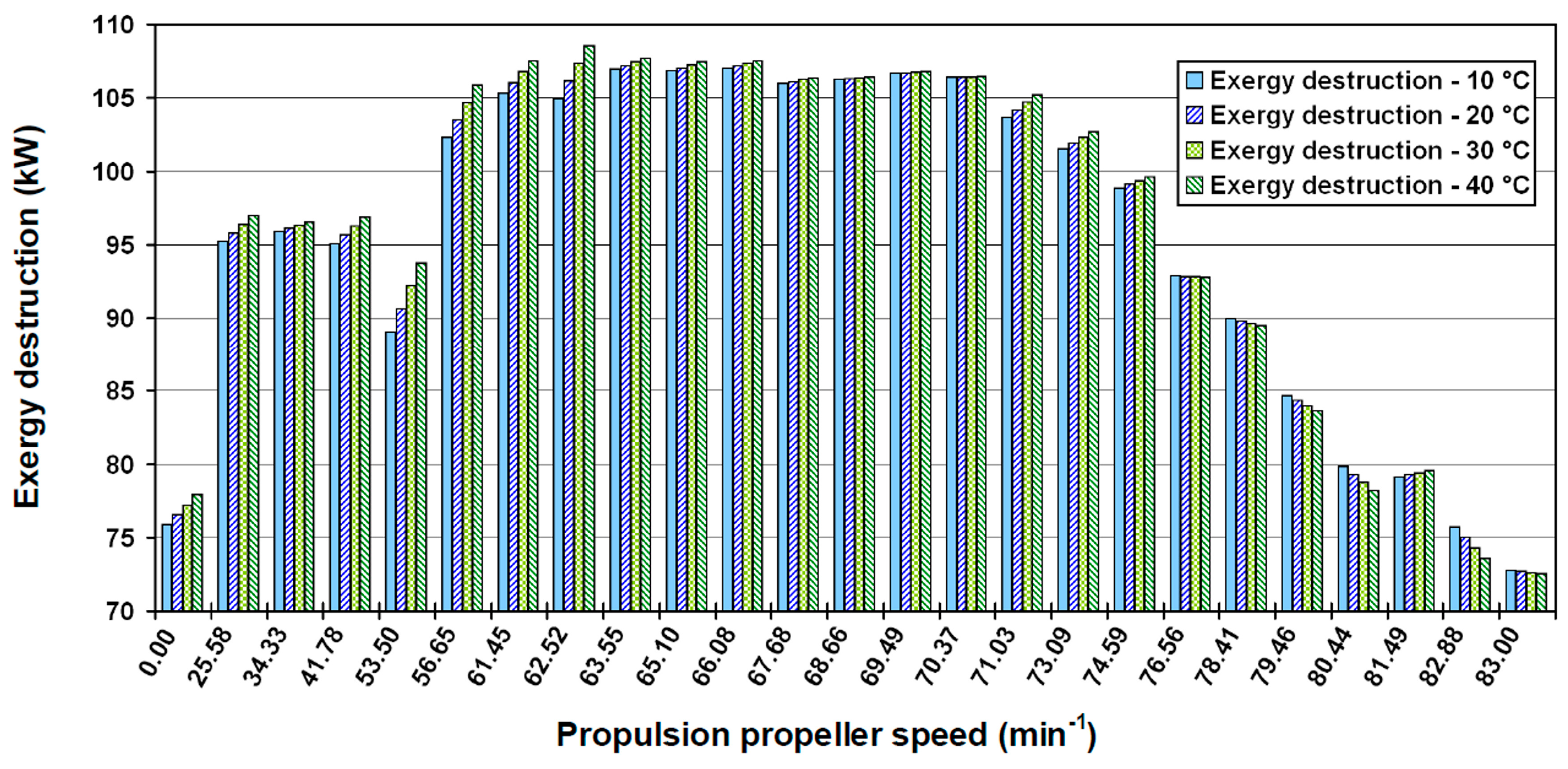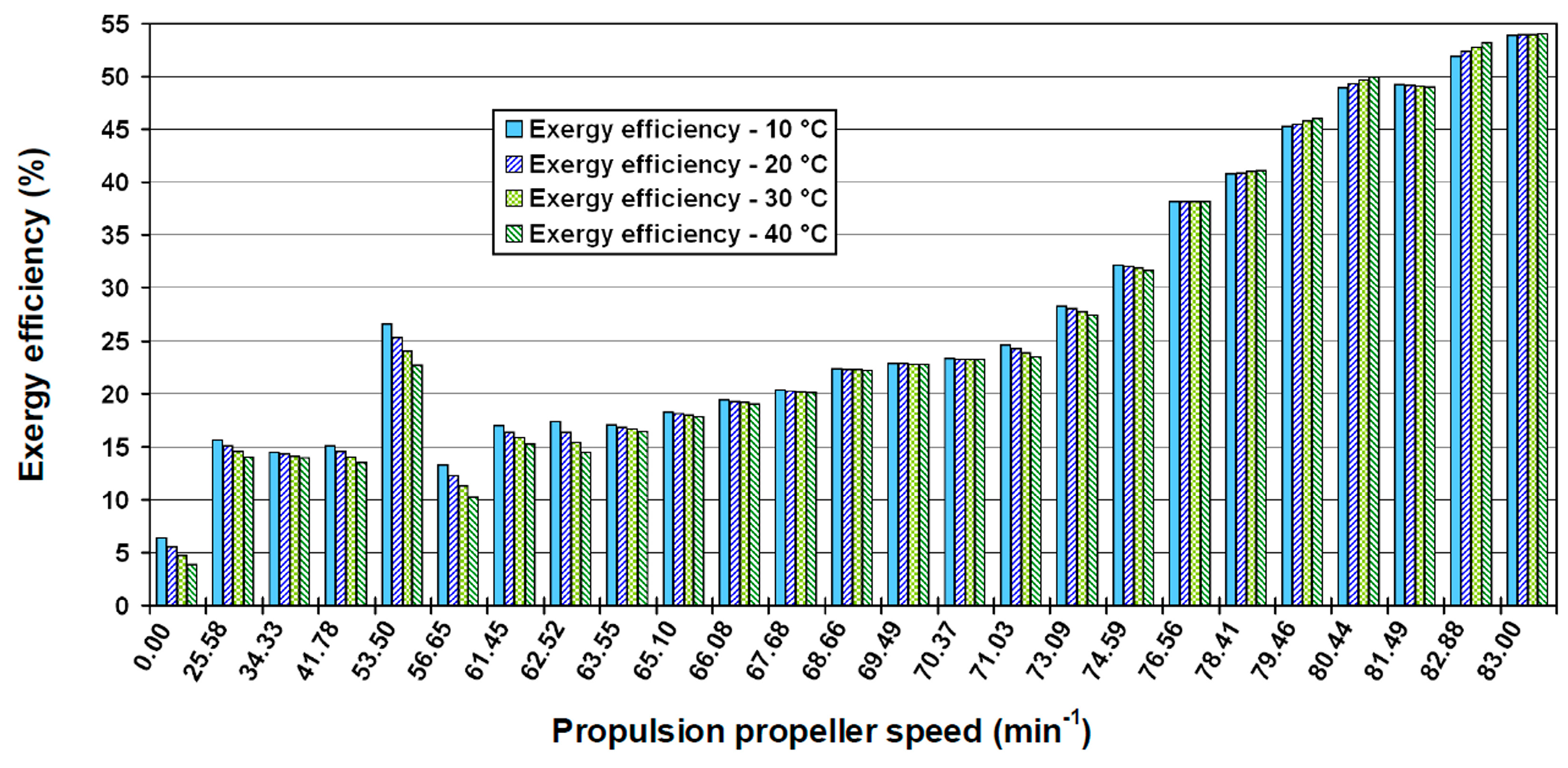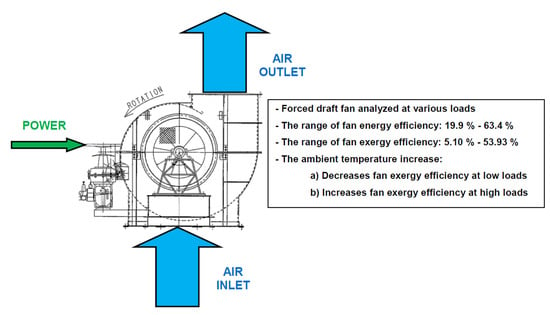1. Introduction
For many years, fans are indispensable devices in the energy processing industry and in power plants. In addition to other uses, fans are also used for the supply of combustion air into steam generators, which is also the main purpose of the fan analyzed in this paper. Without a proper and timely supply of air, the steam generator operation would be at least difficult or even impossible. In general, fans can be divided into two main types: axial fans and radial (centrifugal) fans [
1,
2]. Both fan types were investigated from various aspects by a large number of scientists and experts.
For an axial flow fan, Ye et al. [
3] provided a numerical simulation of the pressure pulsation and transient flow field using a computational fluid dynamics (CFD) analysis. The approximate entropy and the sample entropy models can be used to identify the abnormal blade deviation at all observed operating points.
The influence of the blade installation angle for windward axial fans on the performance of an air-cooled power plant was investigated by He et al. [
4,
5]. The blade installation angle of the axial fans is modified off the design case to obtain a new power plant performance, which is compared to the design value at a prevailing wind angle and five different designated wind speeds. It was found that the alternation of the blade installation angle for the windward fans changes the performance of the fan array. The net power of the power plant and the thermal efficiency of the closed Rankine cycle are influenced by the alternation of the blade angle in axial fans.
Energy dissipation in the blade tip region of an axial fan was investigated by Bizjan et al. [
6]. The authors analyzed two different rotor blade tip designs: a standard design with straight blade tips and a modified design with swept-back tip winglets. The comparison of integral sound parameters indicated a significant noise level reduction for the modified blade tip design. The analysis presented a novel experimental method based on simultaneous measurements of local flow velocity and pressure.
Nowadays, turbofan engines are commonly used for the propulsion of passenger aircrafts [
7]. The fans in these engines are axial flow fans driven by gas turbine [
8]. In order to reduce the specific fuel consumption of these engines, Huang et al. [
9] and Lu et al. [
10] presented upgrades with air-driven axial flow fans by increasing the bypass ratio.
The widespread use of centrifugal (radial) fans in engineering has resulted in many different geometrical designs in order to meet the application requirements [
11]. The application ranges from large scale industrial dryers and air conditioning units to smaller scale blowers for augmenting heat transfer in portable electronics.
An integrated performance analysis for a backward-inclined centrifugal fan was presented by Lin and Tsai [
12]. Their analysis proposed two modification alternatives based on flow visualization at each operating point, after having verified the successful enhancement of fan performance via numerical calculation.
The effect of the axial gap between the inlet nozzle and impeller on efficiency and flow pattern in centrifugal fans was investigated by Gholamian et al. [
13].
Chunxi et al. [
14] numerically and experimentally analyzed the performance of a centrifugal fan with an enlarged impeller. The authors made comparisons for the fan operating with the original impeller and with two larger impellers, where the outlet diameter increased by 5% and 10%. The internal characteristics were obtained by numerical simulation, which indicated a larger volute loss in the fan with larger impeller. The experimental results showed that the flow rate, total pressure rise, shaft power and sound pressure level increased, while the efficiency decreased in the fan with a larger impeller.
Fernández Oro et al. [
15] presented a numerical methodology for the assessment of relative and absolute deterministic flow structures in the analysis of impeller-tongue interactions in centrifugal fans. The studied squirrel cage fan is a small centrifugal fan with a twin impeller configuration. This type of squirrel cage fan is often used as blowers in automobile applications or as small-scale industrial equipment.
An experimental and numerical study of a small forward–curved centrifugal fan was presented by Lin and Huang [
16], while a similar investigation of a miniature centrifugal fan was presented by Tsai and Wu [
17]. Both investigations were based on the results of the experimental setup and numerical analysis. The results showed the capabilities of the design, analysis, manufacturing and measurement of small-scale centrifugal fans.
The centrifugal fan based on a flap-adjustment has been investigated by Chen et al. [
18] through theoretical, experimental and finite element methods. To obtain a centrifugal fan with improved performance, the authors carried out a comparative analysis of aerodynamic performances which included an adjusted blade angle, total pressure, efficiency, system-efficiency, adjustment-efficiency and the energy-saving rate.
Recently, researchers have been intensively involved in studying and analyzing the noise produced by various types of fans, along with the means for noise reduction.
Paramasivam et al. [
19] presented the tonal noise prediction in a small high-speed centrifugal fan with experimental validation. A CFD analysis was performed using a 3-D detached eddy simulation (DES) to compute the unsteady flow field in the fan. The calculated time history of the surface data from the CFD is used in the Ffowcs Williams-Hawkings (FW-H) solver to predict the far field noise levels.
The direct noise prediction and control of a large low-speed radial fan was presented by Sanjose and Moreau [
20]. By adding a thin filter on the bellmouth removes the large turbulent structures ingested by the fan and improves the flow-field uniformity at the fan inlet along with a significant noise reduction and occurrence of additional pressure losses.
The unsteady fan flow field, its characteristics and influences on noise prediction and noise generation was investigated by Trabelsi et al. [
21] for an axial fan. The same fan flow field and its influences on noise were investigated by Wolfram and Carolus [
22] and Zhang et al. [
23] for a radial (centrifugal) fan.
The experimental study of noise reduction for an industrial forward-curved blade centrifugal fan was presented by Datong et al. [
24]. The aim of different experimental tests was to validate whether the effects of different modifications to fan performance and noise are additive as well as to find a good impeller-volute matching to reduce the centrifugal fan noise without the loss of performance. The experimental results showed that a good coupled modification not only could reduce the fan noise, but could also advance the fan performance and extend its operating range.
Zhang et al. [
25] investigated vane sweep effects on fan interaction noise. For fan broadband noise, the backward sweep succeeds in reducing the sound power level for a wide range of frequencies. Due to the statistical average effect, the efficiency relies much on the shape of the turbulence spectrum.
A numerical optimization with the aim of reducing vibration noise of a centrifugal fan volute was performed by Zhang et al. [
26]. The results showed that the proposed vibration noise optimization method can effectively reduce vibration noise in the fan and a maximum noise reduction value of 7.3 dB was obtained.
Several authors investigated the causes which lead to the failure of fans and its components. Nurbanasari et al. [
27] presented a damage analysis of the forced draft fan blade in a coal fired power plant. There were two main locations of blade damage, at the root of the blade and at the third of the blade height. A visual inspection, metallographic analysis, chemical composition and hardness tests were carried to find the exact cause of the failure. The failure at the third of the blade height is due to external particles colliding on the leading edge of the blades, which causes erosion and a notch. The notch acted as an initial crack. The failure at the root of the blade was caused by broken fragments of other damaged blades.
Trebuna et al. [
28] analyzed the causes of radial fan failure. The numerical and experimental methods were used for identifying the reasons for fan failure. The authors analyzed residual stresses in the rotating wheel of the fan and performed measurements of vibration diagnostic parameters in running fans.
Many fans, as the one analyzed in this study, are driven by induction motors. Likewise, in power plants, fans driven by induction motors are also used for air supply systems of buildings and are responsible for significant power consumption [
29]. A detailed CFD analysis of the fan electrical drive was presented by Ding et al. [
30].
Large scale fans are irreplaceable components in the energy processing industry and in power plants. It is therefore necessary to analyze them properly in order to understand the optimal operating parameters both for fans as single components and for entire plants.
Viorel-Mihai and Ioan [
31] analyzed the vibrations in the flue gases exhaust fan of a cogeneration power plant. Comparing the measured vibrations to those obtained by a mathematical model, they revealed a hidden connection near one of the cassettes with coil springs. This hidden connection, which was unintentionally created during cassettes mounting, was responsible for a mechanical asymmetry.
Wang et al. [
32] analyzed a power-saving control strategy for reducing the total pressure in the primary air fan of a coal-fired power plant. The proposed power-saving control strategy was applied to a 1000 MW commercial power plant. The industrial-scale experiments demonstrated that the power consumption of the primary air fan reduced by as much as 465 kW for a load of 500 MW, representing a fan power reduction of 15% relative to the conventional control strategy.
Wang et al. [
33] investigated ash fouling on the blades of an induced fan in a 330 MW coal-fired power plant with ultra-low pollutants emission. Sulfates enrichment and high humidity in flue gases were two key factors that gave rise to the formation of massive fouling deposits on the fan blades. The accurate monitoring of ammonia concentrations at the outlet of the selective catalytic reduction (SCR) reactor and the adequate design of the temperature drop of flue gases in the low-temperature economizer should be carried out in coal-fired power plants with an ultra-low pollutant emission.
While performing energy and exergy analyses of power plants, a small number of authors presented an analysis of fans as integral components of power plants. This kind of analysis, not only for fans, but also for the other plant components is usually presented on the highest plant load, and rarely at partial loads [
34]. In power plants, fans are used for different tasks. Therefore, their dimensions, driving power and operating parameters can vary greatly.
One of the few papers in which the exergy analysis of fans is studied along with other power plant components is authored by Uysal et al. [
35]. In the observed power plant, two fans were used for the supply of combustion air to the steam generator. The authors presented exergy destruction and exergy efficiencies of both fans for the highest power plant load. The exergy efficiency of Fan1 was 63.16%, while the used power was 1360 kW. At the same highest plant load, the exergy efficiency of Fan2 was 75.64%, while the used power was 1320 kW.
The above-referenced research focused mainly on the analysis of fan geometry and design, air flow characteristics, fan vibrations, noise and fouling as well as on the possibilities for the improvement of fan performance and efficiency. However, the analysis of fan performance, including energy and exergy efficiency, especially under fan load variations, has been neglected in the literature. This paper presents an advancement over the existing research since it brings an analysis of the energy and exergy performance and efficiency of a forced draft fan under load variations in a marine steam propulsion system. Furthermore, this paper investigates the factors impacting the fan performance, such as the air temperature difference between the fan inlet and outlet, the air mass flow rate and the ambient temperature. This paper presents a method for determining fan exergy and energy efficiencies by calculating specific air enthalpies and entropies from the measurements of fan temperatures and pressures and obtaining the fan power from the measurements of induction motor currents, all for a wide range of marine steam propulsion loads. The observed steam propulsion system operates on a conventional liquefied natural gas (LNG) carrier and the observed forced draft fan is used for the supply of combustion air to the steam generator.
6. Results and Discussion
One of the essential elements for the energy and exergy analyses of the forced draft fan is the power produced by the electrical drive and distributed to the forced draft fan. The fan driving power varies according to the system load and is calculated by Equations (20) and (21) along with the measured current from
Table 5. The driving power is determined for all of the observed propulsion system loads (propulsion propeller speed) and the results are presented in
Figure 4.
When comparing the calculated results for the forced draft fan driving power (
Figure 4), with the measured current from
Table 5, it can be noticed that the fan driving power is directly proportional to the induction motor current. During the steam system startup (propulsion propeller speed of 0.00 min
−1), the fan driving power is 80.99 kW and increases almost continuously during an increase in the steam system load. At the highest system load (83.00 min
−1), the fan driving power is equal to 157.63 kW. The presented change in the fan driving power is expected because an increase in the steam system load simultaneously increases the fuel amount into the steam generator. An increase in the fuel consumption leads to an increase in the air mass flow rate supplied to the steam generator by the forced draft fan in order to maintain complete combustion. The higher air mass flow rates through the forced draft fan necessitate higher power consumptions in the fan drive. This fact is justified with the simultaneous change of the forced draft fan power consumption and the change in the air mass flow rate, as shown in
Figure 4 and
Table 4.
The energy power input and output of the forced draft fan, calculated by Equations (12) and (13), for the observed steam system loads, are presented in
Figure 5. The fan power input and output increase (almost continuously with some variations) during an increase in the steam system load. The difference between the energy power input and output represents the fan energy power loss, which is of a much lower scale than the entire energy power input and output, as shown in
Figure 5.
The lowest values of the fan energy power input and output can be seen during the steam system startup: 2239 kW for energy power input and 2182 kW for energy power output. An increase in the steam system load results with an almost continuous increase in the fan energy power input and output. Hence, the highest values of fan energy power input and output are obtained at the highest observed system load (propulsion propeller speed of 83.00 min−1) and are equal to 9192 kW for the energy power input and 9117 kW for the energy power output.
For all of the observed steam system loads, it can be concluded that the energy power input and output of the forced draft fan are well balanced since the difference between those two is small. Therefore, the energy power losses are low in the entire operating range. Unfortunately, a low energy power loss does not lead to high energy efficiency in the analyzed forced draft fan.
The energy power input of the forced draft fan (Equation (12)) consists of two components: The first part is the energy power of the air flow stream (product of air mass flow rate and specific enthalpy), while the second part is the power delivered to the fan. It is of interest to analyze the shares of these two components in the fan energy power input and to compare them against the fan exergy power input, which also consists of exergy power of the air flow stream and power delivered by the induction motor drive.
Figure 6 shows that the air flow stream takes a dominant share in the fan energy power input (from 96.38% for the lowest, up to 98.29% for the highest observed steam system load). Except at the steam system startup (propulsion propeller speed of 0.00 min
−1), the electrical drive power represents a share lower than 2.5% in the energy power input for all of the steam system loads.
During steam system startup, the share of electrical drive power in the energy power input is the highest (3.62%) due to the lowest air mass flow rate through the fan (4.80 kg/s,
Table 4). At the first, the higher system load (propulsion propeller speed of 25.58 min
−1), the share of electrical drive power share reduced to 2.22% due to a significant increase in the air mass flow rate through the fan (from 4.80 kg/s at 0.00 min
−1 up to 11.24 kg/s at 25.58 min
−1). At the highest steam system load (propeller speed of 83.00 min
−1), the air mass flow rate through the forced draft fan is the highest (
Table 4) and the share of electrical drive power in the energy power input is the lowest with 1.71%.
The conclusion drawn from
Figure 6 is that an increase in the steam system load (along with some minor deviations) increases the air flow stream share (due to increase in the air mass flow rate) and simultaneously decreases the electrical drive power share in the fan energy power input. Likewise, it should be highlighted that the influence of the electrical drive power on the forced draft fan energy power input is minor when compared to the air flow stream.
The energy power loss, calculated by Equation (14), and the fan energy efficiency of the forced draft fan, calculated by Equation (15), are shown in
Figure 7 for all of the observed steam system loads. The fan energy power loss and energy efficiency have no monotonic trends during an increase in the steam system load. It is therefore essential to identify the variable (or more of them) which has the strongest influence on the fan energy power loss and energy efficiency of the forced draft fan.
According to Equation (14), the fan energy power loss depends on four variables: air mass flow rate, driving power and air specific enthalpies at the fan inlet and outlet. The forced draft fan is a device whose primary purpose is increasing the air velocity (not the air pressure). This fact can be seen from the small pressure differences between the fan outlet and inlet, as listed in
Table 4. Therefore, the air pressure cannot significantly affect the fan energy power loss. The air mass flow rate almost continuously increases with an increase in the steam system load (
Table 4). The power consumption of the forced draft fan (
Figure 4) follows the trend of the air mass flow rate. Therefore, neither the air mass flow rate nor the fan driving power can have the largest impact on the fan energy power loss. The largest impact on the fan energy power loss is from the air temperature, precisely the air temperature difference between the fan inlet and outlet. The higher air temperature differences result in lower energy power loss and vice versa.
The lowest energy power loss of the forced draft fan is 44.4 kW for the propulsion propeller speed of 53.50 min
−1 (
Figure 7), where the air temperature difference between the fan outlet and inlet is 6 °C (
Table 4). When observing the propulsion propeller speeds between 63.55 min
−1 and 70.37 min
−1, it can be seen that the highest energy power losses of the forced draft fan are between 99.9 kW and 105.8 kW, while the air temperature difference is 2 °C (
Table 4). For the highest steam system loads, the fan energy power loss varies significantly. At 81.49 min
−1 and 83.00 min
−1 the fan energy power losses are 74.9 kW and 74.8 kW, with an air temperature difference of 4 °C. At 82.88 min
−1 the fan energy power loss is 95.5 kW and the air temperature difference between fan outlet and inlet is 3 °C.
The energy efficiency of the analyzed forced draft fan has the opposite behavior to the energy power loss, meaning that when the fan energy power loss increases, the energy efficiency decreases and vice versa. In the observed range of steam system loads, the fan energy efficiency ranges from 19.9% (at 34.33 min−1) to 63.4% (at 53.50 min−1). At the highest steam system load (83.00 min−1), the forced draft fan energy efficiency is 52.5%, which is important since, at this system load, LNG carriers operate for the major part of the time. It can be concluded that, on average, the energy efficiency of the analyzed forced draft fan is below 40% for in the low to middle range of system loads. The fan energy efficiency increases to 50%, on average, only at the highest steam system loads (from 81.49 min−1 to 83.00 min−1).
The exergy power input (Equation (16)) and the exergy power output of the forced draft fan (Equation (17)) are presented in
Figure 8, for the observed range of steam system loads. During an increase in the steam system load, both the exergy power input and output increase almost continuously. When compared to the energy power input and output, which are in the scale of thousands of kW (
Figure 5), the exergy power input is up to 170 kW, while the exergy power output is lower than 100 kW. The cause of this is in the values of air specific enthalpies (fan energy power input and output) and air specific exergies (fan exergy power input and output). The air specific enthalpies are from 438.5 kJ/kg (fan inlet) to 454.65 kJ/kg (fan outlet) while the air specific exergies are from 0.32 kJ/kg (fan inlet) to 4.44 kJ/kg (fan outlet). The values of air specific exergy (at fan inlet and outlet) are small, but not zero, because of how the ambient state was defined (
Section 4.2.).
The lowest exergy power input of the forced draft fan is 85.8 kW and occurs for a propulsion propeller speed of 0.00 min−1, while the highest fan exergy power input of 164.2 kW occurs at the highest system load (83.00 min−1). The lowest values of exergy power input and output are obtained for propeller speed of 0.00 min−1, while the highest values of exergy power input and output are obtained for propeller speed of 83.00 min−1.The lowest exergy power output is 8.9 kW, while the highest exergy power output is 91.6 kW. The exergy power output is not influenced by the electrical drive power since it contains only the exergy power of the air flow stream (Equation (17)).
The highest variation in the fan exergy power input and output occurs between the propulsion propeller speeds of 41.78 min
−1 and 56.65 min
−1. The main reason for the sudden increase from 41.78 min
−1 to 53.50 min
−1 is a significant increase in the electrical drive power, from 111.93 kW to 121.25 kW. The exergy power input of the air flow stream increases by only 2.28 kW between these two propeller speeds, mostly because the air mass flow rate increases from 11.09 kg/s to 12.75 kg/s (
Table 4). The increase in the air mass flow rate is the main reason for the fan exergy power output increase between propeller speeds of 41.78 min
−1 and 53.50 min
−1. However, it should be noted that the air temperature increase at the fan outlet, which is from 45 °C to 50 °C, also influences the observed increase in the fan exergy power output.
A notable decrease in the fan exergy power input is noticed from 53.50 min
−1 to 56.65 min
−1. This is mainly caused by the decrease of electrical drive power from 121.25 kW to 117.91 kW. Between these two propeller speeds, the exergy power input of the air flow stream shows a decrease of 2.96 kW, caused mostly by the decrease in air mass flow rate from 12.75 kg/s to 12.28 kg/s (
Table 4). Between propeller speeds of 53.50 min
−1. and 56.65 min
−1, the decrease in fan exergy power output is caused by the decrease of air temperature at the fan outlet, from 50 °C to 44 °C, while the decrease of air mass flow rate has an important, but not primary influence.
The exergy power loss (exergy destruction) of the forced draft fan represents the difference between the exergy power input and exergy power output. From
Figure 8, it can be seen that, in general, the differences between the fan exergy power input and output decreases, during the increase of the propeller speed (along with some deviations at lower steam system loads). Therefore, the lowest exergy power loss (the lowest exergy destruction) is expected to occur at the highest propulsion propeller speeds.
Similar to the energy power input, the exergy power input is also composed of two parts (Equation (16)): the electrical drive power and the exergy power of the air flow stream. The shares of electrical drive power and air flow exergy power in the exergy power input are presented in
Figure 9, for the entire range of observed steam system loads.
From
Figure 9, it can be clearly seen that the dominant share in the exergy power input is from the electrical drive power (between 94.21% and 96.58%) for the entire range of steam system loads. Due to the small values of air specific exergy at the fan inlet (between 0.32 kJ/kg and 1 kJ/kg), the exergy power of the air flow stream represents a smaller share in exergy power input, from 3.42% to 5.79%.
At low propulsion propeller speeds (under 63.55 min−1), the shares of electrical drive power and air flow exergy power in the fan exergy power input exhibit abrupt changes, which are caused by the changes in the air mass flow rates. In the range of propulsion propeller speeds from 63.55 min−1 to 83.00 min−1, the share of air flow exergy power shows a continuous increase, while the share of electrical drive power share shows a continuous decrease. Again, these trends are for the major part influenced by the change in the air mass flow rate.
When comparing the shares of electrical drive power and air flow stream in the energy power input (
Figure 6) and exergy power input (
Figure 9), it is clear that they are inversely proportional. In the fan energy power input, the dominant share is from the air flow stream while in the fan exergy power input, the dominant share is from the electrical drive power. The reasons for this inverse proportionality are found in the values of air specific enthalpy (required for fan energy power input calculation) and in the values of air specific exergy (required for fan exergy power input calculation). The values of air specific enthalpy are much higher than the values of air specific exergy.
The exergy power loss or exergy destruction (Equation (18)) and the exergy efficiency of the forced draft fan (Equation (19)) are presented in
Figure 10 for the entire range of propulsion propeller speeds.
The exergy destruction depends primarily on the current of the induction motor and on the air mass flow rate. For higher propulsion propeller speeds, the exergy destruction is also influenced by the air pressure at the fan outlet (
Table 4).
The highest exergy destruction of 107.3 kW occurs for propulsion propeller speed of 63.55 min−1, while the lowest exergy destruction of 72.6 kW occurs for the highest propulsion propeller speed of 83.00 min−1. In the entire range of steam system loads, the average exergy destruction is 95.95 kW.
It is important to explain the decrease of exergy destruction in the range of propulsion propeller speeds from 71.03 min
−1 to 83.00 min
−1. In this load range, the air mass flow rate and the fan driving power increase almost continuously. The air temperature and pressure at the fan inlet are constant in that load range, while the air temperature at the fan outlet is almost constant, as reported in
Table 4. The term
reduces the exergy destruction when the system load increases since the air pressure at the fan outlet continuously increases. An exception occurs between propulsion propeller speeds of 80.44 min
−1 and 81.49 min
−1 where the fan exergy destruction slightly increases. The continuous increase of air pressure at the fan outlet, with almost constant air temperature, causes a continuous increase in the outlet air specific exergy. Along with the increase in air mass flow rate, the increase in air specific exergy at the fan outlet causes the term
to increase faster than the fan driving power, which reduces the fan exergy destruction (Equation (18)) in the range of propeller speeds from 71.03 min
−1 to 83.00 min
−1.
In general, the exergy efficiency of a steam system component is inversely proportional to the exergy destruction. An increase in exergy destruction results with a decrease in exergy efficiency and vice versa. The change in exergy efficiency is directly proportional to the change of the air mass flow rate and, therefore, directly proportional to change of fan driving power for all of the observed steam system loads. An increase in the air mass flow rate leads to a simultaneous increase in the fan driving power, which causes an increase in the fan exergy efficiency. Conversely, a decrease in the air mass flow rate causes a decrease in the fan exergy efficiency. The lowest fan exergy efficiency is 5.10% and occurs for the lowest air mass flow rate of 4.80 kg/s (driving power 80.99 kW) when the propulsion propeller speed is 0.00 min−1, at the steam system startup. The highest fan exergy efficiency is 53.93% and occurs for the highest air mass flow rate of 20.60 kg/s (driving power 157.63 kW) when the propulsion propeller speed is 83.00 min−1.
This direct dependence between the exergy efficiency and the air mass flow rate (or driving power) is best seen between propulsion propeller speeds of 80.44 min
−1 and 82.88 min
−1. Between propulsion propeller speeds of 80.44 min
−1 and 81.49 min
−1, a slight decrease in the fan exergy efficiency (from 49.43% down to 49.06%) can be seen in
Figure 10. This decrease occurs because the air mass flow rate decreases from 20.23 kg/s to 20.11 kg/s, while the fan driving power decreases from 156.18 kW to 155.71 kW.
When the propulsion propeller speed increases from 81.49 min−1 to 82.88 min−1, the fan exergy efficiency increases from 49.06% to 52.54%. This is caused by the increase in the air mass flow rate from 20.11 kg/s to 20.50 kg/s, while the fan driving power increases from 155.71 kW to 157.25 kW.
It can be concluded that the highest fan exergy efficiency can be obtained for the highest air mass flow rate and the highest fan driving power. A similar conclusion can be drawn for the fan energy efficiency (
Figure 7). From the viewpoint of energy and exergy efficiency, the forced draft fan is a well-balanced device because, generally, the highest efficiencies are achieved for the highest steam system load, where the major part of LNG carrier operation is expected.
Compared against similar fans used in land-based steam power plants [
35,
85], the analyzed forced draft fan achieves significantly lower energy and exergy efficiency at the highest observed load. Future research on forced draft fans for marine applications should be focused on the possibilities for increasing its energy and exergy efficiency.
In the energy and exergy analyses of land-based steam power plants, several authors investigated on the influence of ambient temperature on the exergy destruction and exergy efficiency of steam plant components. A change in ambient temperature has no influence on the energy power loss or energy efficiency of the steam plant component [
53]. Ahmadi and Toghraie [
58], Aljundi [
81], Kopac and Hilalci [
82] and Ameri et al. [
86] investigated the influence of ambient temperature on several land-based steam plant components. In general, they concluded that a change in ambient temperature has a low impact on the exergy destruction and exergy efficiency of most components in steam power plants. The only exception is the steam condenser, for which exergy destruction and exergy efficiency showed that they are influenced by ambient temperature.
Orović et al. [
59] found that heat exchangers used in steam power plants (not only steam condensers) can be very sensitive to a change of ambient temperature, from the exergy aspect. For the analyzed steam air heater, the authors found that an increase in ambient temperature of 10 °C reduces the heat exchanger exergy efficiency by 5%, on average.
The general conclusion is that an increase in ambient temperature causes an increase in exergy destruction and a decrease in exergy efficiency to most of the components in steam power plants. As a general rule of thumb, a change in ambient temperature of 10 °C causes a change of 1% in the exergy efficiency of the steam power plant component.
The influence of ambient temperature on the exergy destruction and exergy efficiency of the analyzed forced fan draft is also studied in this paper.
The influence of ambient temperature on the exergy destruction of the forced draft fan is shown in
Figure 11. It can be noticed that, unlike other steam plant components, the forced draft fan exhibits a different behavior in terms of exergy destruction with respect to the ambient temperature.
For low and middle propulsion propeller speeds (from 0.00 min−1 to 74.59 min−1), the fan exergy destruction increases with an increase in the ambient temperature. In this range of steam system loads, the lowest fan exergy destruction is 75.85 kW and occurs for ambient temperature of 10 °C (0.00 min−1). On the other hand, the highest fan exergy destruction is 108.53 kW and occurs for ambient temperature of 40 °C (62.52 min−1). In this range of steam system loads, the average exergy destructions are: 100.74 kW for ambient temperature of 10 °C and 102.20 kW for ambient temperature of 40 °C. An increase in ambient temperature of 10 °C causes an increase of exergy destruction by 0.49 kW on average, in the range of low to middle steam system loads.
For high propulsion propeller speeds (from 76.56 min−1 to 83.00 min−1), the change in exergy destruction is very interesting. In this load range, fan exergy destruction decreases with an increase in ambient temperature, with the exception at propeller speed of 81.49 min−1. This is an unusual change for most of steam plant components and must be explained in detail.
The fan exergy destruction is calculated from Equation (18). In this equation, for a given steam system load and regardless of the ambient temperature, two terms remain constant: the air mass flow rate and the fan driving power. When the ambient temperature changes, the air specific exergy at the fan inlet and outlet also changes. Both of these two specific exergies achieve highest values for the lowest ambient temperatures, at 10 °C. An increase in the ambient temperature causes a decrease in both specific exergies. The rate of decrease in the specific exergies during the increase of ambient temperature defines the change in the exergy destruction.
For low and middle propulsion propeller speeds (from 0.00 min−1 to 74.59 min−1), an increase in ambient temperature of 10 °C causes a decrease in air specific exergy at the fan outlet () larger than the decrease in air specific exergy at the fan inlet (). Therefore, from Equation (18), the term increases with an increase in ambient temperature, which leads to a larger exergy destruction, in the range of propeller speeds between 0.00 min−1 and 74.59 min−1.
At higher propulsion propeller speeds, from 76.56 min−1 to 83.00 min−1, a different trend is detected. An increase in ambient temperature of 10 °C causes a decrease in air specific exergy at the fan outlet () smaller than the decrease in air specific exergy at the fan inlet (). Therefore, from Equation (18), the term decreases with an increase in ambient temperature, which leads to a smaller exergy destruction, in the range of propeller speeds between 76.56 min−1 and 83.00 min−1. At high steam system loads, the only exception occurs at the propulsion propeller speed of 81.49 min−1 where an increase in ambient temperature leads to an increase in exergy destruction, same as in the range of low to middle steam system loads.
In the range of high propeller speeds (from 76.56 min−1 to 83.00 min−1), the average exergy destruction is 82.10 kW at ambient temperature of 10 °C, while it is 81.37 kW at ambient temperature of 40 °C. Thus, an increase in ambient temperature of 10 °C causes an average decrease of fan exergy destruction by 0.25 kW.
For the analyzed forced draft fan, during a change in ambient temperature, the exergy efficiency is inversely proportional to the exergy destruction, as shown in
Figure 12.
In the range of propulsion propeller speeds from 0.00 min−1 to 74.59 min−1, an increase in ambient temperature causes a decrease in the exergy efficiency of the forced draft fan. In this load range, the lowest fan exergy efficiency is 3.86% and occurs for propulsion propeller speed of 0.00 min−1 and ambient temperature of 40 °C. On the other hand, the highest fan exergy efficiency is 32.15% and occurs for propulsion propeller speed of 74.59 min−1 and ambient temperature of 10 °C. In the range of low to middle steam system loads, the average exergy efficiency is 19.66% for ambient temperature of 10 °C and 18.43% for ambient temperature of 40 °C. An increase in the ambient temperature of 10 °C causes a decrease in the fan exergy efficiency by 0.41%, on average.
In the range of high steam system loads, between propulsion propeller speeds of 76.56 min−1 and 83.00 min−1, an increase in ambient temperature causes an increase in the exergy efficiency for almost all of the observed steam system loads. The lowest fan exergy efficiency is 38.12% and is obtained for the propulsion propeller speed of 76.56 min−1 and ambient temperature of 10 °C. On the other hand, the highest fan exergy efficiency is 54.00% and is obtained for the propulsion propeller speed of 83.00 min−1 and ambient temperature of 40 °C. The average exergy efficiency is 46.86% when ambient temperature is 10 °C and 47.33% when ambient temperature is 40 °C. An increase in ambient temperature of 10 °C causes an increase in fan exergy efficiency by 0.16%, on average, in the range of high steam system loads. The only exception is seen at the propulsion propeller speed of 81.49 min−1.
Therefore, it can be concluded that a change in ambient temperature does not have a significant influence on the exergy efficiency of the forced draft fan. A change in ambient temperature of 10 °C causes a change in fan exergy efficiency smaller than 0.5%, in the entire range of steam system loads.
